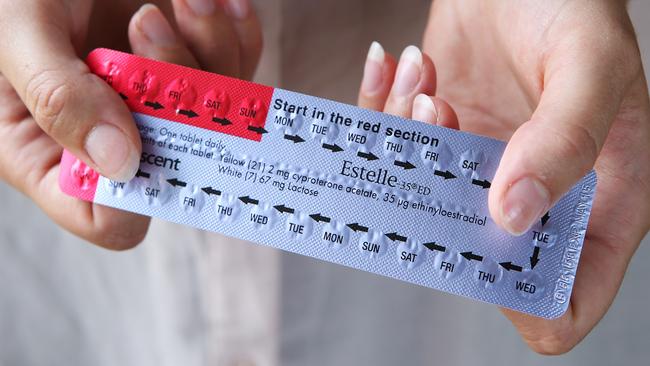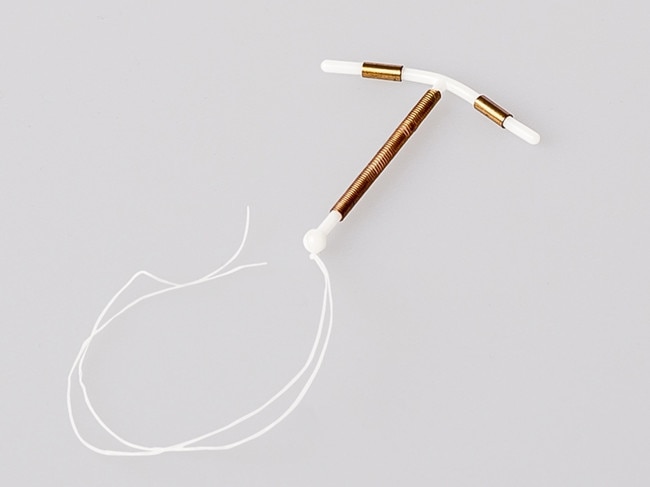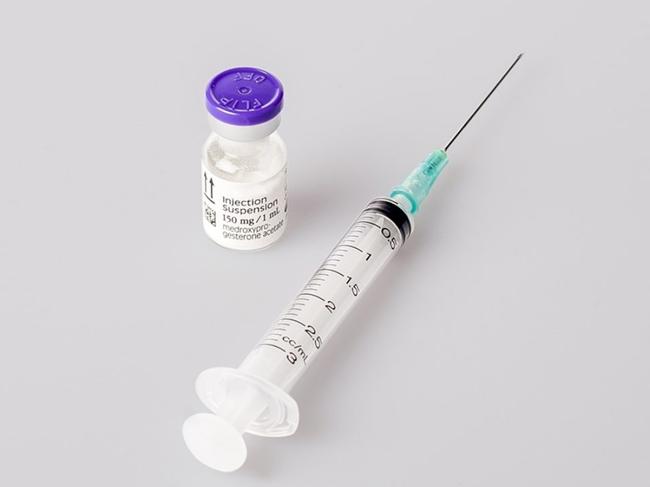Aussie women urged to break up with the contraceptive pill
Australian women are still relying on the contraceptive pill even though it is 60 years old. But experts say it is time to move with the times.
Pregnancy
Don't miss out on the headlines from Pregnancy. Followed categories will be added to My News.
Exclusive: It’s meant to be the day for romance but Aussie women are being urged to use this Valentine’s Day to break up with the contraceptive pill.
This year marks 60 years since the pill revolutionised women’s lives, but there are now many more effective, cheaper and longer acting forms of contraception which are being overlooked.
Instead, a third of all Australian women use the old fashioned method as their preferred contraception, risking an unintended pregnancy and spending a fortune on medication bills.
In 2019, 2.3 million Australian women collected a script for the pill.
Ninety per cent of Australian women who take the oral contraceptive have forgotten to take one of their pills at some point, a new survey has found.
And one in 10 have fallen pregnant while on the pill a YouGov survey of 1000 women found.
Half those using the pill have had to resort to backup or emergency contraception such as condoms or the morning-after pill.
Almost one in three women forget to take their daily pill at least every six months and they report suffering stress and sleepless nights due to concern they may have fallen pregnant, the survey found.

Family planning expert Dr Meredith Frearson who last year completed a Churchill Fellowship on long acting contraceptives said Valentine’s Day was an opportunity for women to re-evaluate “the often-strained relationship they have with the pill”.
Dr Frearson’s research found 20 per cent of European women used long acting reversible contraception but in Australia it was far lower at just 12.5 per cent.
Most women weren’t aware the effectiveness of the pill in the real world was just 91 per cent compared to the 99 per cent for a contraceptive injection, implant or IUD, she said.
Barriers to their increased use include fear of the devices themselves and the insertion process, in addition to lack of access to trained inserters, her research found.
Australia has few nurse IUD inserters and the Medicare rebate for a GP to insert IUDs is just $55 here compared to £100 ($A193) in the UK.
“IUDs are somehow seen as the ‘Dark Arts’ of contraception and it is important that we dispel myths,” she said.
Family Planning NSW lists 13 alternatives to the classic contraceptive pill that women and men can consider including a female condom, a three monthly contraceptive injection, a long acting implant inserted in the arm, a vaginal ring and emergency contraceptive pill, and IUD’s.

Medical director of Family Planning NSW Dr Deborah Bateson said “Australian women have not moved with the times”.
“There is misinformation that IUD’s are not suitable if you have not had children when they can be used by young women,” she said.
Long acting contraception was also far cheaper for individuals and governments.
The contraceptive pill costs between $23 and $77 every three months but an implantable contraceptive device costs $41 and lasts three years, IUD’s costs between $41 and $70 but can last for up to 10 years.
New South Wales Family Planning studies last year found if women switched from the pill to a long-acting contraceptive, they could save up to $157 a year, over five years. The total saving would be $93 million for consumers.
Dr Frearson did concede there was some pain involved in the insertion of IUD’s and she said for a short period after the insertion some women could experience cramping.
There is a small amount of bleeding for the first few months but later many women stopped bleeding altogether or had a 75-85 per cent reduction, the same was true for contraceptive implants.

Freelance make-up artists and hospitality worker Kaarin Helmer said she started using the contraceptive pill when she was 15 to help deal with skin issues and kept using it for almost a decade.
She stopped taking it six months ago because she kept forgetting to take it.
“Doing shift work you don’t have a normal routine,” she said.
“Sometimes I’d remember two days later and I’d have a panic waiting for days to find out whether I was pregnant or not,” she said.
“I was just forgetting it so often I didn’t want to rely on it and I realised it would be easier not to be on it.”
During a working trip to Europe she found workmates over there were using long acting contraceptives and, while they reported that it took a while for their bodies to get used to it, she’s unsure if she will switch.
The 29-year-old said it was unfair responsibility for contraception always fell on women but she said she wouldn’t trust men to take a male contraceptive pill if one was invented.
The YouGov survey was funded by pharmaceutical giant Bayer which sells both contraceptive pills and a long acting contraceptive IUD.
CONTRACEPTION OPTIONS
The hormonal IUD cost $41
It is a small ‘T’ shaped plastic device. It’s placed inside the uterus by a specially trained doctor or nurse to release small amounts of the hormone progestogen for up to five years.
You may experience some irregular vaginal bleeding in the first few months. • Putting the IUD into the uterus can be a bit painful, especially if you haven’t had children. • There is a small chance of infection in the first three weeks after it’s inserted which could lead to pelvic inflammatory disease (PID) – PID may rarely affect fertility later on.
The hormonal IUD is 99.8% effective at preventing pregnancy
Benefits
• You don’t have to remember to take a pill every day.
• Periods usually become lighter and sometimes stop altogether.
• Starts working right away if it’s put in during the first five days of your period.
• Fertility returns as soon as it’s taken out.
• Safe to use if you’re breastfeeding or can’t take oestrogen.
• An inexpensive form of contraception in the long term if you have a Medicare card.
Problems
• Hormonal IUDs don’t protect against STIs but you can use condoms at the same time.
• You may experience some irregular vaginal bleeding in the first few months.
• Putting the IUD into the uterus can be a bit painful, especially if you haven’t had children.
• There is a small chance of infection in the first three weeks after it’s inserted which could lead to pelvic inflammatory disease (PID) – PID may rarely affect fertility later on.
Side effects
Serious problems are rare with the hormonal IUD.
You may experience:
• cramping when it’s put in
• an increase in vaginal discharge
Other side effects are rare because of the low dose of hormones, but you may notice similar side effects to the progestogen-only pill (POP).

The Copper IUD cost $70
It is a small plastic and copper device. It’s placed inside the uterus by a specially trained doctor or nurse and stays there for 5 or 10 years depending on the type.
Benefits
• You don’t have to remember to take a pill every day.
• It starts working right away.
• Fertility returns as soon as it’s taken out.
• Doesn’t contain any hormones.
• Safe to use if you’re breastfeeding or can’t use hormonal methods of contraception.
The Copper IUD is 99.2-99.4% effective at preventing pregnancy.
Downsides
Periods could be heavier and last longer than before.
You may experience:
• cramping when it’s put in
• heavier periods which last longer
• an increase in vaginal discharge
• Copper IUDs don’t protect against STIs but you can use condoms at the same time
• There’s a small chance of infection in the first three weeks after its inserted which could lead to pelvic inflammatory disease (PID) – PID may rarely affect fertility later on.

The contraceptive implant cost $41
Implanon is a small plastic rod which is inserted underneath the skin on the inside of the upper arm. It can stay there for up to three years to slowly release the hormone progestogen. It lasts for three years but if it doesn’t suit, you can have it removed.
Benefits
• You don’t have to remember to take a pill every day.
• The implant is immediately effective if inserted during the first five days of your period.
• It’s not obvious that you have an implant.
• It lasts for three years but if it doesn’t suit, you can have it removed.
• It’s safe to use if you’re breastfeeding or if you can’t take oestrogen.
• Fertility returns as soon as it’s taken out.
• It’s an inexpensive form of contraception in the long term if you have a Medicare card.
The implant is 99.9% effective at preventing pregnancy.
Downsides
In One in five women regular period patterns will change and you can get unpredictable or irregular bleeding (talk to your doctor about this as there are many ways to manage it)
• The contraceptive implant does not protect against STIs but can be used at the same time as condoms.
• The implant can only be inserted or removed by a trained professional in a minor surgical procedure.
• Insertion and removal can cause bruising and some soreness.
• It may leave a very small scar.
Side effects
You may experience:
• tender breasts
• headaches
• mood changes
• one in five women can experience irregular vaginal bleeding, although some have no bleeding at all.

Contraceptive injection $31-$38 every three months
DMPA is a long-acting hormone which is injected every 12 weeks into the buttock or upper arm. After a few injections, monthly bleeding may stop altogether.
Benefits
• You don’t have to remember to take a pill every day.
• Safe to use if you’re breastfeeding or you can’t take oestrogen.
• Can be useful if you don’t want to have periods.
DMPA is 99.8% effective at preventing pregnancy, but in real life it can be less effective (94%) if you’re late for an injection.
Downsides
• DMPA does not protect against STIs but can be used at the same time as condoms.
• You need to remember to get the injection every 12 weeks.
• It is not immediately reversible. This means that any side-effects can take some time to wear off. It can take some months for periods and fertility to return to normal.
Side effects
You may experience:
• irregular bleeding, although this usually gets better with time and most women end up with no periods at all after having the injections for a year
• possible weight gain
• headaches
• tender breasts
• acne
• loss of bone density

The contraceptive pill $23-$77 every 3 months
The Pill is taken once a day and contains two hormones called oestrogen and progestogen.
Benefits
• Periods usually become lighter, more regular and less painful.
• Some women use the Pill to skip their periods altogether.
• Acne often improves.
• Symptoms of premenstrual syndrome (PMS), such as mood changes before a period, may improve or go completely.
• Some Pills are cheaper than others.
The Pill is 99.7% effective at preventing pregnancy if it is taken perfectly, but in real life it can be less effective (91%) because pills can be forgotten or missed.
Downsides
• The Pill does not protect against STIs but can be used at the same time as condoms.
• You must remember to take the Pill every day. If you have difficulty remembering, you may want to set a daily reminder or alarm on your phone. Alternatively, you may prefer a long acting reversible contraceptive that you don’t need to remember to take, such as the contraceptive implant.
• The Pill will not work properly if you – are taking certain medication at the same time (ask your doctor) – forget to take it – are vomiting or have severe diarrhoea If any of these things happen and you have sex, the Pill may not work properly. You may want to use Emergency Contraception (page 24). Another form of contraception, like condoms, should also be used until you’ve been taking the Pill correctly again for seven days.
Side effects
Most women have very few side effects. Those who do experience them often find they settle down within the first few months. You may experience:
• tender breasts
• headaches
• feeling sick (nausea)
• bloating
• mood changes
• irregular spotting (breakthrough bleeding)

